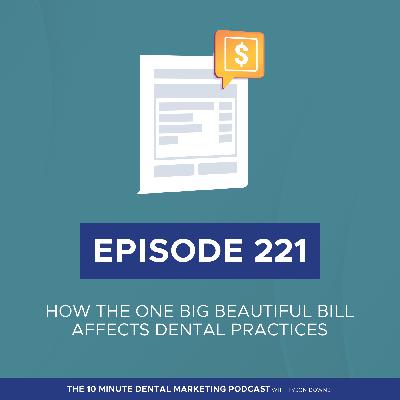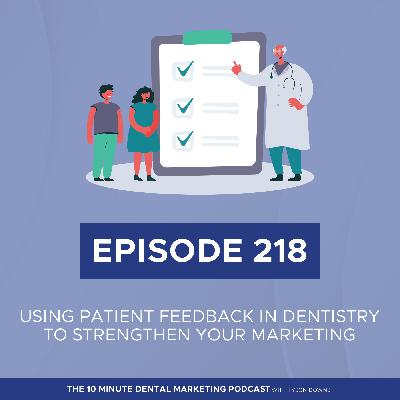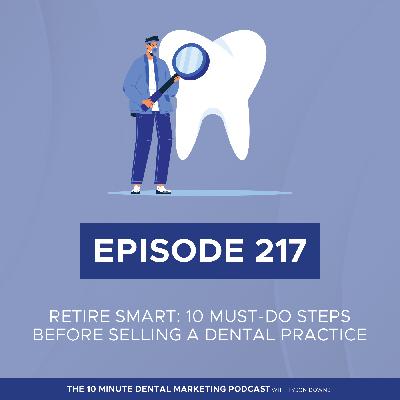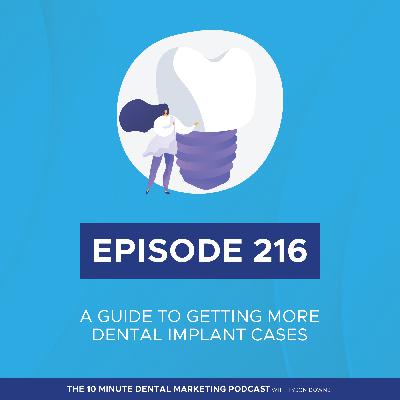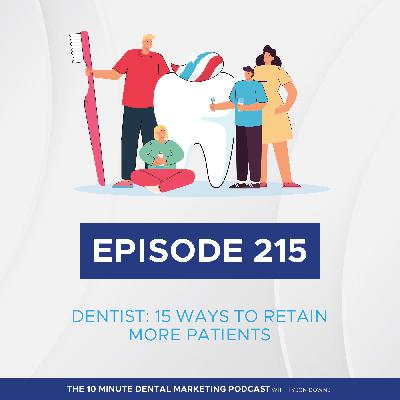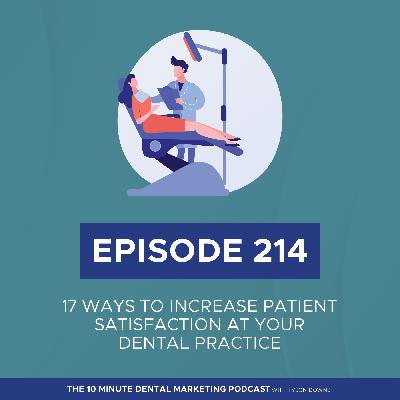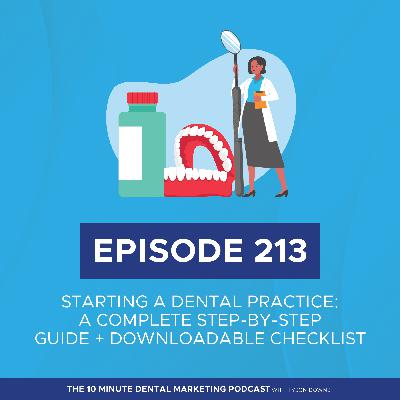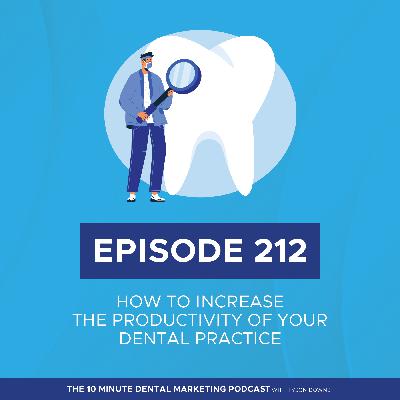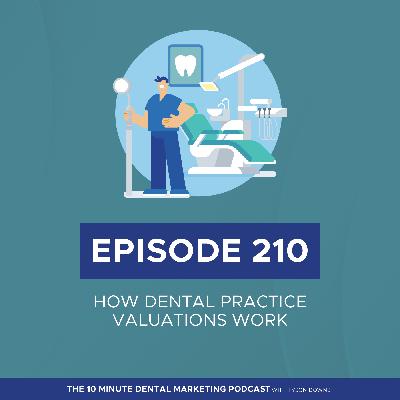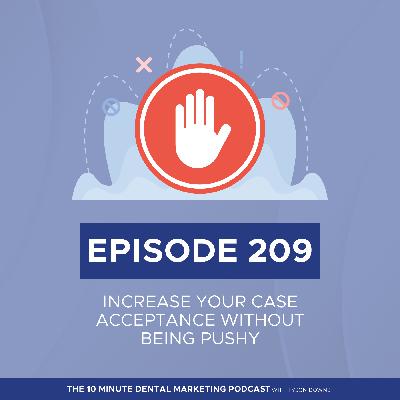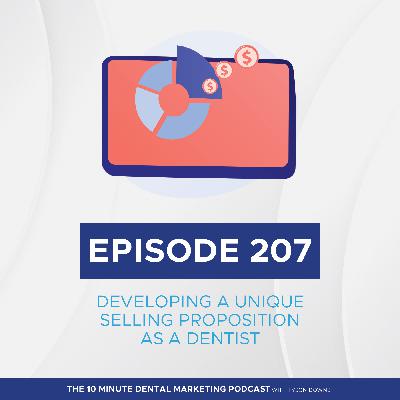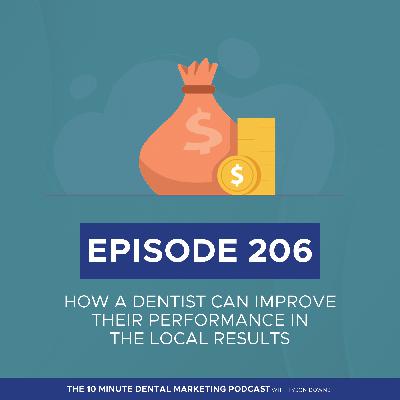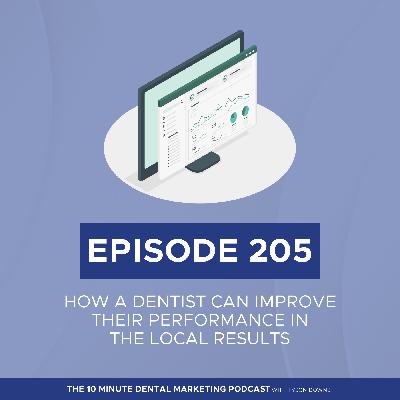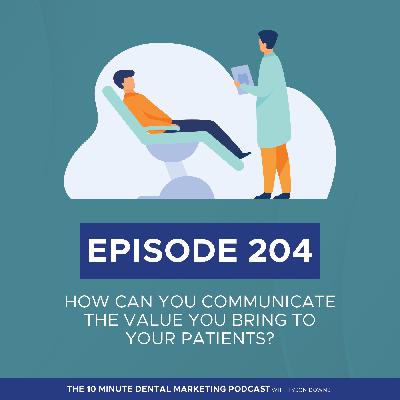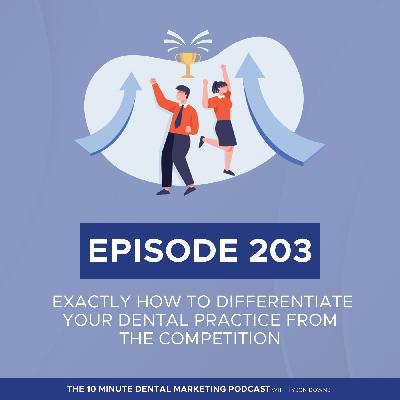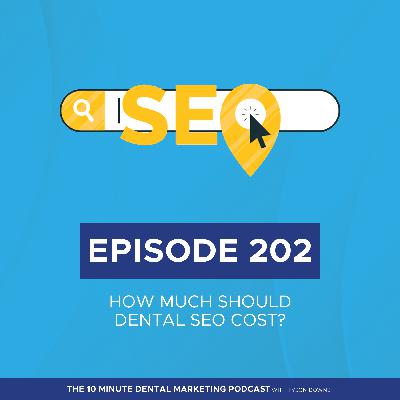Discover The 10 Minute Dental Marketing Podcast
The 10 Minute Dental Marketing Podcast

The 10 Minute Dental Marketing Podcast
Author: Tyson Downs
Subscribed: 71Played: 457Subscribe
Share
© Copyright 2025 . All rights reserved.
Description
The 10-Minute Dental Marketing Podcast delivers brief but powerful and actionable marketing tips and strategies to help you grow your practice and take it to new heights. Visit our website at https://titanwebagency.com to learn how to get more new patients who are searching each day for a dentist in your area.
218 Episodes
Reverse
Introduction
Recent federal legislation introduced tax and programmatic changes that affect dental practices, particularly pass-through entities and practices with meaningful Medicaid exposure. These show notes summarize the core provisions that commonly affect dental owners and outline near-term planning considerations. Continue reading (or listening) to see how the One Big Beautiful Bill impacts dental practices.
What You’ll Learn
Which provisions are most likely to affect dental pass-through practices
How depreciation, Section 179, and qualified business income rules may change equipment and taxable income treatment
Which practices may benefit and which face revenue or compliance risk related to program changes
Concrete tax-planning actions to discuss with your CPA
Implementation timelines and practical next steps
Key Segments
Major Tax Changes Explained
Review how depreciation and expensing rules apply to recent equipment purchases and planned capital spend.
Evaluate the impact on taxable income calculations for owner-managed pass-through entities.
Qualified Business Income and Pass-Throughs
Reassess QBI calculations and thresholds in light of updated guidance; some planning that worked historically may need adjustment.
Medicaid and Programmatic Effects
Practices with significant Medicaid patient volumes should model revenue changes and billing implications tied to program updates.
Near-Term Planning Actions
Inventory recent capital purchases and planned buys; confirm optimal timing with your CPA.
Revisit entity structure and owner compensation strategies where relevant.
Ensure payroll and withholding systems are aligned with any new employer-related provisions.
Compliance and Reporting
Confirm new reporting deadlines and forms that may affect practice administration.
Document policy changes and maintain supporting records for audit readiness.
Conclusion
The legislative changes present both planning opportunities and operational risks. Work with your CPA to model specific impacts, prioritize timing for capital decisions, and update reporting processes. Treat this as an item for immediate review on your next financial planning cycle.
A special thanks to Jared Ripplinger, CPA, MBA, CFP®, CVA of Utah Accounting Firm, CMP for writing this blog post.
Introduction
Independent dental practices can stay competitive against larger Dental Service Organizations by emphasizing strengths DSOs find difficult to replicate: deep patient relationships, local reputation, agility, and focused service positioning. These show notes summarize practical, local-first strategies to protect and grow an independent practice.
What You’ll Learn
Why independence is a defensible position versus DSOs
How to convert patient relationships into measurable marketing advantages
Local SEO and review strategies that move the needle
Operational and technology choices that improve patient experience and margins
Quick wins and longer-term initiatives to protect and grow revenue
Key Segments
Personalize Care at Every Touchpoint
Make continuity (same-dentist visits) visible in your messaging and intake flows.
Train front-desk and clinical teams to capture and use patient details for follow-up and retention.
Modernize Technology Where It Matters
Prioritize tech that reduces friction: online intake, easy booking, secure texting, and intraoral imaging.
Choose tools that save time or increase conversion rather than buying every available solution.
Strengthen Local Presence
Optimize your local listings and add location- and service-specific pages so searches map to intent and convert.
Use service-focused pages (for example, “anxiety-free dentistry [city]”) to match search intent.
Treat Customer Service as Clinical Care
Standardize response SLAs for calls and leads; measure and close leads within a set window. Quick, consistent phone handling is a competitive advantage.
Define a Local Niche
Pick one or two specialties (cosmetic, pediatric, sedation, same-day crowns) and own them across your website, social, and community outreach. We see Carlsbad Pediatric Dentist, Afsoon Fazeli doing a great job of this!
Community Visibility
Sponsor or participate in local events, host open houses or hygiene days, and partner with neighborhood organizations to build recognition.
Operational & Financial Discipline
Track patient mix, show rates, reappointment percentage, and marginal profitability by service. Avoid competing on price; optimize margins and capacity.
Conclusion
Independent dentists can win where DSOs cannot: relationship depth, local trust, and operational flexibility. Combine focused service positioning, local search presence, a superior patient experience, and tight operational metrics to convert those advantages into sustainable growth.
Learn more about Tyson Downs, the owner of Titan Web Agency.
Dentists: Get Better Results from Google Ads by Doing This
Introduction
Google Ads are a fast way to reach potential dental patients—but only if you set them up correctly. This episode covers practical tactics to make your dental ads stand out, lower your costs, and attract more qualified new patients. Dive deeper in our source: how dentists can get better results from Google Ads.
What You’ll Learn
The fundamentals of setting up high-ROI dental ad campaigns
Tips for selecting the best keywords and negative keywords
How to boost the quality and relevance of your ads
Tools for tracking conversions (calls and leads)
How to create stronger ad copy and landing pages
Key Segments
Define Your Ideal Patient
Build patient personas to target precisely
Use location, age, and service-specific info
Choose the Right Keywords
Focus on high-intent and local keywords
Add negative keywords to filter out irrelevant clicks
Write Compelling Ad Copy
Highlight your unique services and offers
Use clear calls to action
Optimize Landing Pages
Match landing page content to the ad
Make it easy for visitors to schedule or call
Track and Optimize Performance
Set up conversion tracking for calls and online leads
Analyze results and adjust campaigns for better ROI
Conclusion
Getting the most from Google Ads takes targeted strategy, clear messaging, and constant review. Apply these tips to lower costs, attract more patients, and grow your practice.
A special thanks to Dr. Fazeli of Discovery Children's Dentistry & Orthodontics in Carlsbad, CA, for providing input on this episode.
Using Patient Feedback in Dentistry to Strengthen Your Marketing
Introduction
Patient feedback is more than just reviews—it’s a powerful marketing tool. In this episode, we break down how to collect, analyze, and use patient feedback to drive practice improvement and win trust in your community. Learn more in our source: how to use patient feedback in your dental marketing.
What You’ll Learn
The most effective ways to get feedback from patients
How to use feedback to guide improvements and marketing messages
Practical ideas for managing and collecting more reviews
Tips for addressing negative feedback productively
Tools and systems to automate feedback collection
Key Segments
Request Feedback Regularly
Ask for feedback during or after appointments
Make it easy with digital surveys and follow-up emails
Encourage Public Reviews
Request Google and Facebook reviews after positive visits
Show patients where and how to leave reviews
Monitor and Respond to Feedback
Address concerns in a timely manner
Thank patients for both positive and constructive input
Analyze Trends and Take Action
Identify common themes or suggestions
Implement changes based on what patients want
Leverage Positive Feedback in Marketing
Use testimonials on your website and social channels
Share success stories (with permission)
Conclusion
Collecting—and acting on—feedback helps your practice improve, builds trust, and fuels your marketing with authentic patient success stories.
A special thanks to Dr. Megan Post, DDS of Decatur Dental Care in Decatur, GA for contributing to this episode.
Retire Smart: 10 Must Do Steps Before Selling Your Practice
Introduction
Selling a dental practice is a major milestone. This episode outlines the must-do steps before retirement to help ensure a profitable—and stress-free—transition. You'll get practical advice to maximize your practice’s value and prepare for a smooth sale. Full details are in our source: 10 steps before selling your dental practice.
What You’ll Learn
Key financial, legal, and operational moves to make before selling
How to evaluate your practice and identify potential buyers
Ways to boost your practice’s value before listing
Negotiation and transition tips for a successful handoff
Steps to ensure continuity for staff and patients
Key Segments
Assess Your Practice Value
Gather financial records and assess production
Consider a professional valuation
Clean Up Financials
Settle debts and organize accounts
Remove personal expenses from the business
Increase Practice Appeal
Make necessary repairs or upgrades
Improve curb appeal and office aesthetics
Plan for Tax Implications
Consult with a tax advisor early
Understand the impact of asset vs. stock sales
Choose Professional Advisors
Work with a broker, accountant, and attorney
Get expert input at every phase
Prepare a Transition Plan
Ensure patient and staff continuity
Allow for a smooth handoff to the new owner
Conclusion
Preparation is vital when selling your practice. Take these ten steps to ensure you’re financially secure and that your legacy continues with the next owner.
Your Dental Implant Marketing Guide: 7 Strategies To Generate More Patient Leads
Introduction
Dental implant marketing requires focus and expertise. This episode explores practical strategies to attract patients who need implants and build a strong local reputation. You’ll learn actionable marketing tips to generate more qualified leads and grow your dental implant cases. Read the full guide for even more ideas: 7 strategies to generate dental implant patient leads.
What You’ll Learn
How to identify your ideal implant patient and target them
Digital marketing tactics to increase implant inquiries
SEO and website tips to stand out in local search results
Content ideas that educate and convert patients
Ways to leverage patient reviews and social proof
Key Segments
Define Your Target Patient
Use demographic and behavioral data to profile likely implant candidates
Focus marketing on patients most likely to benefit
Optimize Your Website for Implants
Create dedicated implant service pages with before-and-after photos
Use strong calls to action to drive inquiries
Invest in Local SEO and Paid Ads
Target local keywords for implants in ads and website content
Use Google Ads and Facebook campaigns for targeted reach
Educate Through Content Marketing
Develop blog posts, videos, and FAQs about implants
Address common concerns and highlight patient outcomes
Leverage Patient Reviews and Testimonials
Display positive implant reviews on your website and profiles
Encourage patients to share their stories online
Build Partnerships and Community Presence
Connect with specialists, general dentists, and local organizations
Participate in events to raise implant awareness
Track Leads and Measure Results
Use call tracking and online forms to monitor campaigns
Regularly review ROI and update tactics to improve performance
Conclusion
A focused marketing approach helps you reach more implant patients and grow your cases. Apply these strategies to generate consistent leads and become your area’s trusted implant provider.
Dental Patient Retention: 15 Strategies to Increase Your Retention Rate
Introduction
Retaining your current dental patients is critical for practice stability and growth. This episode explains simple, high-impact ways to improve patient retention—helping you deliver better service while maximizing practice revenue. Get all the details from our source: 15 strategies to increase your dental patient retention rate.
What You’ll Learn
The essentials of patient communication for long-term loyalty
Practical ways to keep scheduling simple and convenient
Systems that help you follow up and personalize care
How small touches and rewards keep patients returning
Staff training tips to make every visit positive
Key Segments
Communicate Proactively
Remind patients of upcoming appointments
Check in after procedures to ensure satisfaction
Make Scheduling Easy
Offer online scheduling and text reminders
Provide flexible appointment times
Personalize Patient Experience
Remember patient details and preferences
Send personalized birthday or holiday messages
Offer Membership or Loyalty Programs
Reward repeat visits with discounts or perks
Solicit and Act on Feedback
Ask for patient input via surveys
Implement suggestions that benefit the patient experience
Train Staff for Consistency
Regularly review customer service standards
Empower staff to solve problems quickly
Conclusion
Patient retention isn’t just about dental care; it’s about making patients feel valued at every step. Use these practical strategies to keep more patients coming back and recommending your practice.
17 Ways to Increase Patient Satisfaction at Your Dental Office
Introduction
Satisfied patients are more likely to refer friends and return for future care. In this episode, you'll learn how small, actionable changes in your dental office can create a better experience for every patient. We go over proven steps to keep patients happy and loyal. Get more insights from our source: ways to increase patient satisfaction at your dental office.
What You’ll Learn
Proven methods to improve patient satisfaction
How to reduce wait times and streamline appointments
Ways to create a welcoming and comfortable environment
How to gather and use patient feedback for improvements
Tips for training your team to deliver better service
Key Segments
Improve Patient Communication
Clearly explain procedures, costs, and care
Answer patient questions and set clear expectations
Streamline the Check-in Process
Offer digital forms and clear signage
Make check-in fast and welcoming
Focus on Comfort and Cleanliness
Maintain a clean, calming environment
Add amenities like music, refreshments, and comfortable seating
Gather and Act on Feedback
Use surveys or follow-up calls after visits
Implement suggestions to address weaknesses
Train Your Team for Consistency
Regular team training for empathy and professionalism
Ensure each patient gets the same high level of care
Conclusion
Delivering consistent, positive experiences is key to patient satisfaction and practice growth. Implement these simple strategies to build trust, loyalty, and referrals in your dental practice.
Starting a Dental Practice: A Complete Step-by-Step Guide
Opening your own dental practice represents a significant professional milestone, but requires careful planning and execution. This comprehensive guide provides dentists with essential knowledge and practical steps for launching a successful practice, from initial considerations to opening day logistics.
What You'll Learn:
Key financial and personal considerations before starting a practice
Essential business planning and setup requirements
How to select the optimal location and build your patient base
Strategies for efficient practice management and growth
Key Segments:
Financial Realities and Personal Readiness: Starting a dental practice requires substantial working capital—often around $500,000—for office space, equipment, supplies, staffing, and initial marketing. Beyond finances, dentists must honestly assess their readiness to work independently, handle longer hours than employees, and manage the unpredictability of self-employment income despite the eventual rewards of higher earnings.
Comparative Career Advantages: Research indicates dental practice owners earn approximately $100,000 more annually than associate dentists, with the most significant disparity appearing among early-career dentists. Ownership also offers greater job stability, with most practice owners remaining at the same location for over 15 years compared to associates who typically change employers before completing 7 years at a single practice.
Location Selection Strategy: Choosing the right location is crucial for practice success. Thorough research should examine population demographics, area competition, and dentist-to-population ratios. While the national average is approximately 55 dentists per 100,000 citizens, this varies by region and should influence site selection along with differentiating your services from existing practices.
Business Infrastructure Development: The implementation checklist includes essential foundations like applying for necessary licenses, securing provider numbers, developing a marketing strategy, selecting practice management software, establishing communication systems, and creating a professional website—all critical components for operational readiness.
Conclusion:
While starting a dental practice presents significant challenges, proper preparation and strategic planning can lead to greater professional satisfaction, financial rewards, and practice longevity. By following this comprehensive guide's recommendations, dentists can navigate the complexities of practice establishment and position themselves for sustainable success in their communities.
Thanks to Dr. Zachary Miller of Finn Hill Dental in Poulsbo for his contribution to this episode.
How to Increase the Productivity of Your Dental Practice
Introduction
Efficient dental practices prioritize streamlined systems, effective communication, and excellent patient care. This approach not only saves time but also boosts profitability and patient satisfaction. If you’re wondering how to increase productivity in a dental office, implementing proven strategies can make a substantial difference. In this guide, we highlight 28 actionable tips to help your practice work smarter, not harder. For the full breakdown, visit: How to Increase the Productivity of Your Dental Practice .
What You’ll Learn
How to improve patient flow and reduce wait times
Ways to optimize office systems and workflows
Methods to enhance communication between staff
Techniques for managing employee morale and training
Strategies for upgrading technology and patient experience
Key Segments
Enhance Patient Experience
Reduce Waiting Room Time: Train staff to update patients if delays occur and provide specific wait times. Move them from the waiting area to exam rooms promptly. Efficiency here keeps patients satisfied and reduces frustration.
Streamline Intake Procedures: Use digital forms and electronic health records to eliminate manual entry. Data stored digitally is easier to access, saves time, and enhances security.
Optimize Staff Roles and Communication
Standardize Processes: Create clear workflows for tasks like scheduling, billing, and patient handoffs. Reducing inconsistencies minimizes errors and saves time in daily operations.
Hold Daily Morning Huddles: Use short team meetings to review schedules, address concerns, and align everyone’s efforts. Teams that communicate effectively complete tasks faster and with better accuracy.
Adopt Modern Technology
Go Paperless: Digitize patient records, treatment plans, and billing processes. This reduces clutter, speeds up workflows, and enhances collaboration.
Use a Digital Scheduling System: Switch to advanced scheduling tools to track appointments, handle cancellations, and send automated reminders, reducing no-shows and improving time management.
Focus on Employee Morale and Development
Incorporate Regular Training: Offer continuing education opportunities and workshops to keep staff updated on the latest techniques and tools. Well-trained employees boost efficiency and deliver better patient care.
Create a Bonus System: Reward staff for meeting goals like improved patient satisfaction or increased productivity. Incentives can enhance teamwork and engagement.
Upgrade the Office Environment
Improve Lighting and Ergonomics: Invest in proper lighting for treatment rooms and ensure comfortable seating for patients and staff. Such changes improve efficiency and reduce fatigue.
Add Indoor Plants: A greener workspace improves air quality and can reduce stress levels for both employees and patients, fostering a more relaxed, productive environment.
Measure and Adjust Regularly
Track Performance Metrics: Pay attention to patient volume, appointment delays, and procedural times to identify improvement opportunities.
Seek Staff Feedback: Conduct regular surveys or meetings to gather employee input on what’s working and what could be improved.
Conclusion
Increasing productivity in your dental office requires a focus on improved workflows, better communication, and consistent upgrades to your technology and environment. By monitoring patient and team dynamics and making adjustments where needed, you can create a more efficient and enjoyable workplace. Implementing the steps above can help you optimize time and resources while enhancing patient satisfaction.
How to Make a High-Converting Landing Page for Your Google Ads Campaigns
Introduction
A landing page plays a critical role in the success of your Google Ads campaigns. For dentists, it’s essential to create a page that quickly grabs attention, delivers value, and drives conversions. But how do you make a high-converting landing page for a dental practice? This episode explains the must-have elements for a landing page that turns visitors into patients. Get more tips here: How to Make a High-Converting Landing Page for Your Google Ads Campaigns.
What You’ll Learn
The essential components of a landing page for dental practices
How clear calls-to-action (CTAs) drive conversions
Why mobile-friendliness is crucial for success
Avoiding clutter and distractions for better performance
Key Segments
Focus on a Single Clear Goal
Every high-converting landing page is built with one primary goal in mind. For dental practices, that goal might be scheduling a consultation, booking an appointment, or downloading an offer like a free guide. Keep the page focused and avoid including unnecessary links or unrelated calls-to-action.
Prioritize Mobile Optimization
Patients often search for dental services on their phones. Ensure your landing page loads quickly, is easy to navigate on small screens, and has clickable buttons. A mobile-friendly layout improves user experience and can significantly boost conversions.
Write a Compelling Headline
The headline is the first thing visitors see when they land on your page. Make it short, engaging, and benefit-focused. Example: “Get a Brighter Smile in Just One Visit!” A strong headline captures attention and encourages visitors to read more.
Use High-Quality Images and Visuals
Images of your dental office, staff, or patient results (with consent) build trust and make your page more personable. Include visuals that align with the services you’re promoting. For example, if the page is for teeth whitening, show before-and-after images.
Feature a Clear and Strong Call-to-Action (CTA)
A well-designed CTA guides visitors to take the next step. Use phrases like "Schedule Your Appointment Now," "Call Today for a Free Consultation," or "Book Online." Place the CTA above the fold, so it’s easily visible without scrolling. Brightly colored buttons with simple language are most effective.
Showcase Patient Testimonials
Positive reviews or testimonials from past patients provide social proof and build credibility. Add quotes or video reviews to show potential patients why others trust your practice.
Highlight Special Offers or Benefits
If your campaign includes a discount or promotion, make it easy to find on the landing page. For instance, “Get $50 off your first appointment!” Adding urgency, like limited-time offers, can further boost conversions.
Simplify the Contact Form
Keep your forms short and simple. Only ask for essential information, such as name, phone number, and preferred appointment time. Avoid overly complicated forms, as they discourage patients from completing them.
Track Performance and Test Frequently
Track metrics like click-through rates, bounce rates, and conversions to measure your landing page's success. Test different headlines, images, or CTAs to see what resonates most with your audience.
Conclusion
To make a high-converting landing page for a dental practice, focus on simplicity, clarity, and mobile optimization. Keep the design clean and centered around one main action, backed by compelling content and strong visuals. By creating a user-friendly experience and testing results, dentists can turn more visitors into scheduled patients with ease.
How Dental Practice Valuations Work
Introduction
Understanding the value of a dental practice is essential for dentists who are planning to sell, merge, or seek financing. But how do dental practice valuations work? A valuation determines the fair market value of a practice by factoring in financial data, patient metrics, and unique characteristics of the business. Learn key insights and methods used to value dental practices in our guide: How Dental Practice Valuations Work .
What You’ll Learn
Why accurate valuations are important for dental practice owners and buyers
An overview of valuation methods and their differences
Key factors that influence the final valuation
The types of records and documents required for an accurate valuation
Key Segments
Reasons for a Dental Practice Valuation
Dental practice valuations matter for several reasons. Practice owners need an accurate valuation to plan for selling, merging, estate succession, or even bringing in new partners. Buyers need valuations to compare practices and ensure they’re making a sound investment. An accurate valuation allows both parties to proceed with confidence.
Common Valuation Methods
Several methods are used to determine a practice’s value:
Capitalization of Earnings Method: Evaluates current profits and future financial performance.
Discounted Cash Flow (DCF): Projects future cash flow discounted to today’s value.
Comparable Transaction Method: Looks at similar practices sold in the area.
Seller Discretionary Earnings (SDE): Focuses on the net income and discretionary spending of the owner.
Each method has its strengths, but using multiple approaches can provide a clearer picture of true practice value.
Key Factors Impacting Valuation
Accurate valuations require an analysis of both tangible and intangible assets:
Financial Data: Gross revenue, net income, and patient collections are critical.
Patient Metrics: Active patient count, new patients per month, and retention rates.
Services Provided: Unique specialties or procedures can increase value.
Location and Market Conditions: Practices in growing areas or with few competitors see higher valuations.
Goodwill: Includes patient loyalty, staff longevity, and the owner's reputation.
Required Records for a Valuation
To conduct a proper valuation, dentists need to provide detailed records, including:
Tax returns and financial statements from the past five years
Patient data, such as active/inactive status and appointment frequency
Employee details, including compensation and tenure
Equipment lists and condition reports
Lease or mortgage documents
Insurance details and payment data
Valuation Costs and Accuracy
A dental practice valuation requires time and expertise. The cost typically ranges from $7,000 to $20,000, depending on the practice size and complexity. While some free estimates may exist, they often lack thorough analysis and accuracy. Investing in a quality valuation is worth the expense for peace of mind and informed decision-making.
Conclusion
Dental practice valuations involve analyzing financials, patient metrics, and market factors to determine fair market value. Understanding how valuations work helps dentists make informed decisions when planning to sell, merge, or grow their practice. By working with professionals and providing detailed records, dentists can feel confident in their valuation and its accuracy.
This is a guest blog post from Jared Ripplinger, CPA, MBA, CFP®, CVA, at CMP, Utah Accountants..
Title: Increase Your Case Acceptance Without Being Pushy
Introduction
Getting patients to accept dental treatment plans is a challenge for many practices, but pressuring patients can create discomfort and mistrust. Dentists need effective strategies to encourage patients to move forward with care while maintaining a patient-first approach. This guide shares practical techniques from 20 Surefire Strategies to Increase Dental Case Acceptance Rate Without Being Pushy, helping you communicate the importance of treatment without being overbearing.
What You’ll Learn
How to build trust and rapport with patients before presenting treatment options
Effective ways to simplify treatment presentations and highlight benefits
Techniques for overcoming patient barriers, such as cost or fear
The importance of using follow-ups and clear communication
Key Segments
Build Trust Through Pre-Consultation Interviews
Start by having a treatment coordinator meet with patients before their consultation. Learn about their previous dental experiences, concerns, and expectations. This builds trust and prepares the patient for a productive conversation with the dentist.
Optimize Your Treatment Presentation
Present treatment plans in clear, simple language. Use visuals like before-and-after photos or videos to help patients understand the benefits. Avoid technical jargon and focus on how the treatment will improve their health and quality of life.
Address Common Objections
Patients often hesitate because of cost, fear, or uncertainty. Offer flexible payment options, such as no-interest plans or discounts for upfront payments. Reassure anxious patients with comforting language, emphasizing painless techniques and modern technology.
Focus on Same-Day Treatments
Patients are more likely to proceed with treatment if they can start it the same day. Whenever possible, provide immediate care for urgent needs. This reduces second-guessing and creates a sense of efficiency and convenience.
Explain the Risks of Delaying Treatment
Educate patients about the health risks and additional costs of postponing care. Use real-world examples to illustrate how untreated dental issues can lead to more serious problems. Informing patients empowers them to make informed decisions.
Follow up Consistently
Not all patients will decide right away. Have your team follow up with calls or messages to check in with those who haven’t scheduled treatment. A polite, non-pushy reminder can prompt patients to take the next step.
Offer a Variety of Payment Plans
Cost is often a major barrier. Help patients afford care by offering flexible financing options. Accepting credit cards, payment plans, and advance discounts makes treatment more accessible.
Learn From Declined Cases
Every rejection is an opportunity to improve. Ask patients who decline treatment for feedback on what held them back. Adjust your approach based on their concerns to better address objections in the future.
Conclusion
Increasing case acceptance rates doesn’t require being pushy. By focusing on trust, communication, and addressing patient concerns with empathy, dentists can encourage more patients to proceed with the care they need. With small changes to the consultation process, payment options, and follow-ups, your practice will foster lasting relationships and see steady growth in treatment acceptance
Thanks to Discovery Children's Dentistry & Orthodontics in Carlsbad for contributing to this episode.
How to Use Your Blog to Bond With Your Target Market
Introduction
Dentists need strong connections with potential and current patients to build trust and loyalty. A blog can help you achieve this by allowing you to share your practice’s values, personality, and expertise in simple language. When used with care, your blog becomes a bridge between you and your community. For practical advice, read the full post: How to Use Your Blog to Bond With Your Target Market.
What You’ll Learn
Simple ways to use blogging to build trust and authority with patients
How to keep blog content positive and relevant
Why showing your staff’s personalities matters
How local content supports community connections
Tips for using blog comments and social media to keep engagement strong
Key Segments
Focus on Positive Aspects of Dentistry
Use your blog to highlight what makes your practice welcoming. Write about new technology, comfort options, friendly staff, and good customer service. This helps patients see your practice as a place they can feel safe and cared for.
See Through Your Readers’ Eyes
Write blog posts that answer common questions or calm concerns. Use a friendly, conversational tone. Ask your readers what topics they want to learn about. This approach makes your blog relatable and relevant for your target market.
Showcase Real People in Your Practice
Let your staff share stories and advice in blog posts. Introduce the team or feature patient success stories (with consent). Real faces and voices help your readers feel a closer connection to your office.
Keep It Local and Community-Oriented
Focus blog topics on events or news in your area. Share ways your practice contributes or offer dental tips around popular community activities. Local stories show that you care about the people you serve, not just the business.
Integrate Social Media and Encourage Interaction
Make it easy to share blog posts on Facebook, Instagram, or other platforms. Invite readers to comment on posts, share their experiences, or ask questions. Respond to comments to show that you value your community’s input.
Be Consistent and Stay Engaged
Post regularly so readers know when to expect new content. Take time to reply to comments and keep conversations going. Regular updates and two-way communication encourage more interaction and trust.
Conclusion
A well-managed blog helps dental practices connect with their target market by sharing helpful information, personal stories, and community news. By writing in a friendly and consistent style, dentists can make their blog a valuable resource—and turn readers into loyal patients.
Dr. Eric Xu, of Precision Dentistry of Olympia is a great example of a dentist using their blog to connect with their target audience.
Developing a Unique Selling Proposition as a Dentist
Introduction
Standing out in the dental industry requires more than just excellent care. To grow your practice, you need to communicate what makes your services different and why patients should choose you. This unique selling proposition (USP) is a cornerstone of effective marketing. In this episode, we’ll explain how dentists can define their USP and how it works in practice. For more insights, check out our post: Developing a Unique Selling Proposition as a Dentist .
What You’ll Learn
What a unique selling proposition (USP) is and why it’s important.
Key steps to identify and communicate your USP as a dentist.
Marketing strategies to highlight your USP both online and offline.
Why a well-defined USP can help you attract and retain patients.
Key Segments
What Is a Unique Selling Proposition?
A unique selling proposition explains how your dental services are different from others. It answers the question, "Why should a patient choose your practice over another?" A strong USP sets you apart from competitors and helps patients understand your value.
How Do You Identify Your USP?
Start by asking yourself what makes your practice special. This could include:
Advanced technology, such as 3D imaging or laser dentistry.
A focus on comfort, such as sedation options or a relaxing environment.
Competitive pricing or specialized payment plans.
Personalization, like catering to families or specific communities.
Talking with patients and staff can also help identify qualities patients value most.
Communicating Your USP Clearly
Your USP should be simple, memorable, and present in all marketing materials. For example, if your focus is on creating a stress-free dental experience, make sure this is clear in your messaging, website content, and patient interactions. Ensure that your USP remains consistent across platforms like your website, social media pages, and email campaigns.
Leveraging Your USP in Marketing
Effective marketing showcases your USP online and offline. Use local SEO to optimize for keywords that reflect your specialty, such as "family-friendly dentist" or "pain-free dentistry." Highlight patient testimonials and reviews that align with your USP. Offline, focus on branded materials like brochures or business cards that emphasize the unique benefits of your practice.
Updating Your USP with Growth
As your practice evolves, so can your USP. For example, if you’ve added new technology or specialties, incorporate these into your messaging. Regularly reviewing your USP ensures that it stays aligned with your strengths and patient expectations.
Conclusion
A well-defined USP shapes your brand and sets you apart from competitors, showing patients why you’re the best choice for their dental care. By identifying your strengths and consistently communicating them, you can attract new patients and build lasting loyalty. Developing a strong USP is not just about standing out; it’s about connecting with the people you serve.
Note, we'd like to thank Dr. Craig Barney, DMD of DeLand Family Dental for his expertise on this post.
How Much Should a Dentist Spend on Marketing?
Introduction
Dental practices often ask, “how much should a dentist spend on marketing?” Knowing the right answer is key to growing your practice and reaching new patients. Setting your marketing budget can feel challenging with so many options and factors involved. This episode explains where to start, what to consider, and how to invest your marketing dollars wisely for the best results. Learn more in our post: how much should a dentist spend on marketing.
What You’ll Learn
What factors influence how much a dentist should spend on marketing
How to calculate a marketing budget for a dental practice
Marketing strategies that deliver value for your investment
Steps to adjust marketing spend as your practice grows
Key Segments
Start with Practice Goals and Growth Stage
When deciding how much a dentist should spend on marketing, first think about your practice's goals and stage. New practices often need to invest more to build brand awareness and bring in patients. Growing or established clinics might need less, with occasional increases for special promotions or new services.
Base Budget on Revenue and Local Competition
Many experts suggest that new practices invest between 20% and 30% of their expected gross revenue on marketing, especially if competition is high. Established dental offices may find that 5% to 10% of revenue is enough for steady growth. Your location’s competitiveness and growth targets play a large role in your decision.
Break Down Spending by Channel
Your budget should cover key strategies like website development, local SEO, paid advertising, and social media. Direct mail campaigns and promotional discounts can also attract new patients. Plan spending to reach the most people and support your biggest goals.
Track Results and Adapt
Use simple tools to track where new patients come from and which marketing efforts work best. Adjust your budget based on what delivers the highest return. Regular review helps you get more value from every marketing dollar.
Ongoing Investments Make a Difference
Marketing is not a one-time event but an ongoing process. To keep up with local competition and changing patient needs, refresh your marketing regularly and set aside a steady portion of revenue each year.
Conclusion
Deciding how much a dentist should spend on marketing depends on your goals, market, and stage of growth. By planning around your revenue, tracking results, and investing in proven strategies, you can reach more patients while spending wisely. A well-thought-out budget gives your practice the best chance for steady growth.
How a Dentist Can Improve Their Performance in the Local Results
Introduction
Dentists need a strong local search presence to attract new patients in their community. Showing up at the top of local search results helps practices reach people who are actively looking for dental services nearby. In this episode, we explore clear steps that help dentists improve local SEO results. Get more details from our source: how dentists improve local SEO results .
What You’ll Learn
How accurate business listings help dentists improve local SEO results
Ways to get more reviews from happy patients
The role of local keywords and website optimization
Techniques for building trust through consistent contact information online
Key Segments
Keep Google Business Profile Up to Date
Dentists improve local SEO results by claiming and updating their Google Business Profile. Add a correct business name, address, phone number, and business hours. Upload quality photos of your office and services. A complete profile helps you show up more often when people search for nearby dentists.
Use Consistent NAP Everywhere
Make sure your Name, Address, and Phone number (NAP) look the same on every website and directory. Inconsistent information confuses search engines and can lower local rankings. Check sites like Yelp, Superpages, and health directories. Contact them to fix any errors.
Get More Citations and Listings
Citations are mentions of your dental practice on trusted websites. Dentists improve local SEO results by adding their business to local directories, dental associations, and city business listings. More citations create trust with search engines and help your practice appear higher in local searches.
Ask for Reviews from Patients
Positive reviews make your practice stand out and help you rank better. After visits, encourage happy patients to leave a review on Google or other reputable platforms. Show appreciation for their feedback and answer reviews to keep the conversation going.
Optimize Website with Local Keywords
Add your city, neighborhood, or region to your website’s titles, content, and image tags. Create service pages using phrases such as "emergency dentist in [your city]." Clear and local-focused content makes it easier for patients to find you online.
Embed Google Maps on Your Website
Put a Google Map on your contact page. This helps Google confirm your location, which can raise your search ranking for local queries.
Increase Social Proof and Engagement
Keep active social media profiles. Share posts about community events, patient success stories (with permission), and office updates. Engagement on platforms like Facebook or Instagram can support your local SEO performance.
Conclusion
Dentists who want to improve local SEO results should focus on accurate business listings, strong reviews, and local website optimization. Consistency and ongoing updates help your practice earn higher local search rankings and attract more patients from your community.
How to Communicate the Value You Bring as a Dentist to Your Patients
Introduction:
Dental practices must clearly show why patients should choose them. Explaining the benefits of your services in simple and direct language helps you stand out. Patients want to know they are getting great care from a practice they can trust. In this episode, we explain how to show patients the value you bring as a dentist.
What You’ll Learn:
How to explain what makes your practice unique.
Ways to share your message with patients online and in person.
The connection between great service and patient loyalty.
Why clear communication helps patients feel confident in your care.
Key Segments:
Explain What Makes Your Practice Stand Out
Think about what your practice offers that others may not. This could be experience, advanced technology, or friendly service. Share these points clearly when talking to patients or creating online content. Patients want to know what makes your care the right choice for them.
Strengthen Your Brand
A consistent and professional look helps patients trust your practice. Your logo, website, and communication should all match. A strong brand creates a good first impression and shows your commitment to quality care.
Use Online Tools to Connect
Communicate your value where patients spend time online. Post updates on social media, write useful blog posts, or share before-and-after photos with permission. An active online presence helps patients learn more about how you can help.
Focus on Exceptional Patient Care
Great care goes beyond treatment. It includes being kind, answering questions, and making the process smooth for each patient. When patients feel respected and listened to, they’ll be more likely to return and recommend your practice to others.
Educate to Build Confidence
Share easy-to-understand information about common dental concerns. Patients feel reassured when they know what to expect. For example, explain procedures step by step or share tips for better oral health.
Conclusion:
Clear communication makes your patients feel valued and confident in your care. By explaining what makes your practice unique, providing helpful resources, and focusing on great service, you can build loyalty and trust. Keep your message simple and consistent to connect with more patients.
How to Differentiate Your Dental Practice from the Competition
Introduction:
Standing out in a crowded dental market is no easy task, yet it’s crucial for growing your practice and attracting loyal patients. Many potential patients may assume that all dental practices are the same, but that couldn’t be further from the truth. This episode explores how to differentiate your dental practice by focusing on quality care, innovation, and strategic patient engagement. Learn how to highlight what makes your practice unique while offering exceptional value to your patients.
What You’ll Learn:
Key strategies to differentiate your dental practice and create a competitive edge.
The role of superior customer service in building long-term patient relationships.
How to create a standout online presence through local SEO and digital marketing.
The benefits of adopting cutting-edge technology and personalized care.
Key Segments:
Focus on Customer Service:
Providing exceptional service is a powerful way to differentiate your dental practice. Patients should feel cared for and valued from the moment they walk through the door. Getting to know them on a personal level, remembering their preferences, and showing genuine concern for their well-being can help build trust and loyalty.
Continuing Education and Expertise:
Stay ahead of the competition by committing to ongoing education for yourself and your staff. Offering the latest in dental technology and staying informed about advancements in the field shows patients your dedication to providing top-quality care.
Keep Your Practice Organized:
A well-run office ensures smooth workflows that elevate the patient experience. From timely appointment confirmations to accurate recordkeeping, operational excellence can set you apart.
Upgrade Technology and Create a Modern Environment:
Patients are drawn to practices with state-of-the-art equipment and modern comfort. Investments in advanced technology, such as same-day crowns or 3D imaging, can enhance service quality and attract tech-savvy patients.
Enhance Your Online Presence:
With more patients searching for dental care online, it’s critical to create a strong digital footprint. Optimize your website for local SEO so your practice appears in search results when patients look for dental services in your area. Additionally, maintain active social media profiles where you showcase testimonials, educational posts, and patient success stories.
Conclusion:
Differentiation is the key to success in a competitive dental industry. By offering exceptional service, personalized care, advanced technology, and a strong online presence, you position your practice as the top choice for prospective and existing patients alike. Remember, it’s not just about attracting new patients but also about fostering loyalty and trust with those you already serve.
How Much Should Dental SEO Cost?
Introduction:
Dental practices know that SEO is essential to staying competitive in today’s digital-first landscape, but many owners find themselves asking, “how much is dental SEO really going to cost me?” The answer depends on numerous factors, from the competitiveness of your local market to the scope of the services you need. If you’re looking to invest in SEO for your dental practice, it’s critical to understand what you’re paying for and how to measure your ROI. This episode breaks down the key elements that influence the cost of dental SEO and offers guidance on setting a realistic budget to grow your practice online.
What You’ll Learn:
The most common factors that affect how much is dental SEO for your practice.
A detailed look at specific SEO services like content creation, link building, and on-page optimization.
Why your location and level of competition play a significant role in determining costs.
Signs that you’re working with an SEO provider you can trust, versus red flags to watch for.
Key Segments:
What Determines the Cost of Dental SEO?
The price of dental SEO services can vary widely depending on your goals and the size of the market you’re competing in. Practices in highly competitive regions may pay significantly more than those in smaller towns. Other factors include the number of keywords you’re targeting, the need for technical improvements to your website, and the quality of content being created.
Breaking Down SEO Services:
SEO is a multi-faceted investment, and understanding the breakdown of services helps you know where your money is going. Typical components include keyword research, technical audits, creating patient-focused blogs, building high-quality links, and optimizing your Google Business Profile for local rankings.
Budgeting Tips: How Much is Dental SEO Really Worth?
For most dental practices, a well-executed SEO strategy can deliver a strong return on investment by increasing website traffic, appointment bookings, and patient inquiries. An experienced SEO provider should help you estimate a budget based on your unique goals and competition. Most experts recommend setting aside between 3% to 5% of your revenue for marketing, with SEO as a core pillar.
Avoiding Common Pitfalls in Dental SEO:
Some providers promise guaranteed rankings or offer extremely low prices, which can be red flags. Successful SEO takes time and consistent effort to see meaningful results, so be wary of anyone claiming otherwise. Transparency, regular reporting, and tailored strategies are hallmarks of a trustworthy partner.
Conclusion:
Investing in dental SEO is an important step toward growing your practice, but understanding the costs and benefits is key to making smart decisions. By selecting the right SEO provider and setting a realistic budget, dental practices can leverage search engine optimization to rank higher, attract local patients, and build long-term success. Let me know what you think of these show notes before I proceed with the others!


